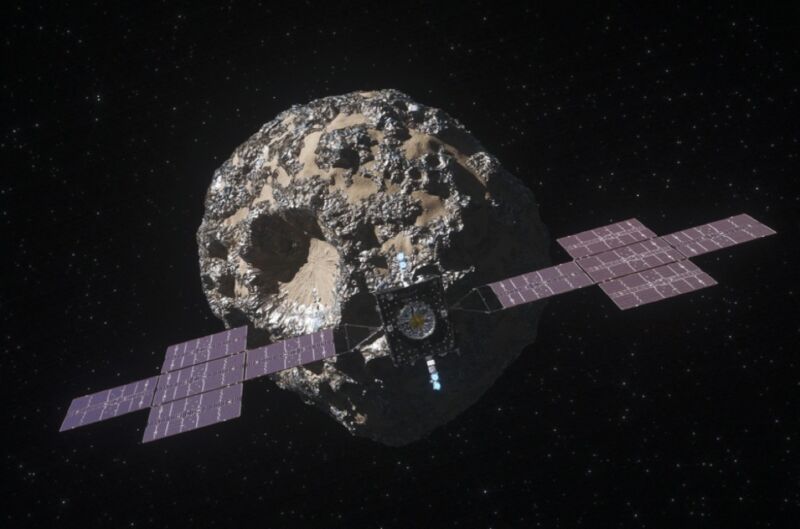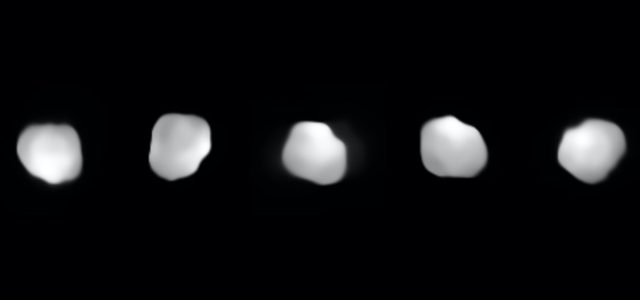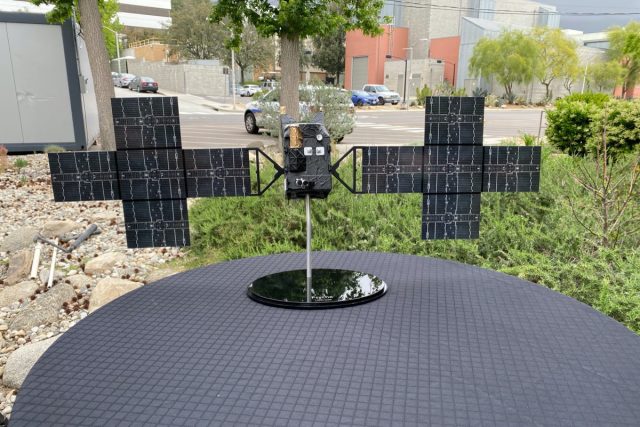
Ars Technica had the opportunity to tour NASA's Jet Propulsion Laboratory in California this week, suiting up for a clean-room sneak peek at the Psyche spacecraft now nearing completion. This ambitious mission, named after the eponymous asteroid it will explore, is due to launch in August on a Falcon Heavy rocket. Scientists are hopeful that learning more about this unusual asteroid will advance our understanding of planet formation and the earliest days of our Solar System.
Discovered in March 1852 by the Italian astronomer Annibale de Gasparis, 16 Psyche is an M-type asteroid (meaning it has high metallic content) orbiting the Sun in the main asteroid belt, with an unusual potato-like shape. The longstanding preferred hypothesis is that Psyche is the exposed metallic core of a protoplanet (planetesimal) from the earliest days of our Solar System, with the crust and mantle stripped away by a collision (or multiple collisions) with other objects. In recent years, scientists concluded that the mass and density estimates aren't consistent with an entirely metallic remnant core. Rather, it's more likely a complex mix of metals and silicates.
Alternatively, the asteroid might once have been a parent body for a particular class of stony-iron meteorites, one that broke up and re-accreted into a mix of metal and silicate. Or perhaps it's an object like 1 Ceres, a dwarf planet in the asteroid belt between the orbits of Mars and Jupiter—except 16 Psyche may have experienced a period of iron volcanism while cooling, leaving highly enriched metals in those volcanic centers.

Scientists have long suspected that metallic cores lurk deep within terrestrial planets like Earth. But those cores are buried too far beneath rocky mantles and crusts for researchers to find out. As the only metallic core-like body discovered, Psyche provides the perfect opportunity to shed light on how the rocky planets in our solar system (Earth, Mercury, Venus, and Mars) may have formed. NASA approved the Psyche mission in 2017, intending to send a spacecraft to orbit the asteroid and collect crucial data about its characteristics.
"Our understanding of what Psyche might be has not changed all that much over the last few years," Linda Elkins-Tanton of Arizona State University, principal investigator of the Psyche mission, told Ars. "It has to have a large metal content, but we've never really known how much. It could be the part of a metal core of a tiny planet from early in the Solar System, or it could be something that never melted and formed a core but has metal mixed into it, like pebbles with the rock. We won't really know until we get there."
Several instruments will be aboard the Psyche spacecraft to collect that precious scientific data. There is a multi-spectral imager capable of producing sufficiently high-resolution images for scientists to tell the difference between the asteroid's metallic and silicate (mineral) constituents. The job of mapping the asteroid's composition and identifying all the elements falls to a gamma ray and neutron spectrometer. There is also a magnetometer that will measure and map any remnants of a magnetic field. Finally, a microwave radio telecommunications system will also be able to measure the asteroid's gravity field, gleaning clues about its interior structure.

The chassis, constructed by a satellite company called Maxar Technologies, was delivered last April. It's roughly the size of a passenger van and was built largely from commercial, off-the-shelf technology. "Once in space, the spacecraft will use an innovative means of propulsion, known as Hall thrusters, to reach the asteroid," Ars Senior Space Editor Eric Berger wrote last year. "This will be the first time a spacecraft has ventured into deep space using Hall thrusters, and absent this technology, the Psyche mission probably wouldn't be happening—certainly not at its cost of just less than $1 billion." Here's a bit more from Berger about this innovative approach:
Engines powered by chemical propulsion are great for getting rockets off the surface of the Earth when you need a brawny burst of energy to break out of the planet's gravitational well. But chemical rocket engines are not the most fuel-efficient machines in the world, as they guzzle propellant. And once a spacecraft is in space, there are more fuel-efficient means of moving around. NASA has been experimenting with [solar electric propulsion] technology for a while. The space agency first tested electric propulsion technology in its Deep Space 1 mission, which launched in 1998, and later in the Dawn mission in 2007 that visited Vesta and Ceres in the asteroid belt.
These spacecraft used ion thrusters. Hall thrusters, by contrast, use a simpler design, with a magnetic field to confine the flow of propellant. These thrusters were invented in the Soviet Union and later adapted for commercial purposes by Maxar and other companies. Many of the largest communications satellites in geostationary orbit today, such as those delivering DirecTV, use Hall thrusters for station-keeping.
Using Hall thruster-based technology enabled the mission's scientists and engineers to design a smaller and more affordable spacecraft. Each of the Hall thrusters on Psyche will generate three times as much thrust as the ion thrusters on the Dawn spacecraft and can process twice as much power. This will allow the spacecraft to reach the Psyche asteroid, located in the main belt, in January 2026, after a 3.5-year journey.
The Psyche team tested the twin solar arrays in March, attaching the arrays to the spacecraft body and unfolding them lengthwise before stowing the panels until the August launch. The five-panel, cross-shaped solar arrays are the largest installed at JPL, measuring 800 square feet (75 square meters). They are specially designed to work in low-light conditions, far away from the Sun.
reader comments
60